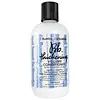What's inside
What's inside
 Key Ingredients
Key Ingredients

No key ingredients
 Benefits
Benefits

 Concerns
Concerns

 Ingredients Side-by-side
Ingredients Side-by-side

Water
Skin ConditioningCetearyl Alcohol
EmollientStarch Acetate
EmollientBehentrimonium Chloride
PreservativeCetyl Esters
EmollientParfum
MaskingPhenoxyethanol
PreservativeIsopropyl Alcohol
SolventHydroxyethylcellulose
Emulsion StabilisingLimonene
PerfumingMaltodextrin
AbsorbentChlorhexidine Dihydrochloride
AntimicrobialHydrolyzed Soy Protein
HumectantHexyl Cinnamal
PerfumingCoumarin
PerfumingLinalool
PerfumingButylphenyl Methylpropional
PerfumingBenzyl Alcohol
PerfumingHydroxycitronellal
PerfumingAmyl Cinnamal
PerfumingGossypium Herbaceum
Skin ConditioningWater, Cetearyl Alcohol, Starch Acetate, Behentrimonium Chloride, Cetyl Esters, Parfum, Phenoxyethanol, Isopropyl Alcohol, Hydroxyethylcellulose, Limonene, Maltodextrin, Chlorhexidine Dihydrochloride, Hydrolyzed Soy Protein, Hexyl Cinnamal, Coumarin, Linalool, Butylphenyl Methylpropional, Benzyl Alcohol, Hydroxycitronellal, Amyl Cinnamal, Gossypium Herbaceum
Water
Skin ConditioningPyrus Malus Fruit Extract
Skin ConditioningCetyl Alcohol
EmollientGlycerin
HumectantPropanediol
SolventCetearyl Alcohol
EmollientCocos Nucifera Oil
MaskingHydrolyzed Rice Protein
Skin ConditioningEmblica Officinalis Fruit Extract
Skin ConditioningHelianthus Annuus Seed Oil
EmollientArginine
MaskingPanthenol
Skin ConditioningTocopherol
AntioxidantLactic Acid
BufferingLauroyl Lysine
Skin ConditioningDicaprylyl Ether
EmollientEthylhexylglycerin
Skin ConditioningBehentrimonium Methosulfate
Brassicamidopropyl Dimethylamine
Skin ConditioningHydroxypropyl Starch Phosphate
Polyester-11
Skin ConditioningHydrogenated Lecithin
EmulsifyingParfum
MaskingLimonene
PerfumingHexyl Cinnamal
PerfumingLinalool
PerfumingHydroxycitronellal
PerfumingDisodium EDTA
Potassium Sorbate
PreservativeSodium Benzoate
MaskingWater, Pyrus Malus Fruit Extract, Cetyl Alcohol, Glycerin, Propanediol, Cetearyl Alcohol, Cocos Nucifera Oil, Hydrolyzed Rice Protein, Emblica Officinalis Fruit Extract, Helianthus Annuus Seed Oil, Arginine, Panthenol, Tocopherol, Lactic Acid, Lauroyl Lysine, Dicaprylyl Ether, Ethylhexylglycerin, Behentrimonium Methosulfate, Brassicamidopropyl Dimethylamine, Hydroxypropyl Starch Phosphate, Polyester-11, Hydrogenated Lecithin, Parfum, Limonene, Hexyl Cinnamal, Linalool, Hydroxycitronellal, Disodium EDTA, Potassium Sorbate, Sodium Benzoate
Ingredients Explained
These ingredients are found in both products.
Ingredients higher up in an ingredient list are typically present in a larger amount.
Cetearyl alcohol is a mixture of two fatty alcohols: cetyl alcohol and stearyl alcohol. It is mainly used as an emulsifier. Emulsifiers help prevent the separation of oils and products. Due to its composition, it can also be used to thicken a product or help create foam.
Cetearyl alcohol is an emollient. Emollients help soothe and hydrate the skin by trapping moisture.
Studies show Cetearyl alcohol is non-toxic and non-irritating. The FDA allows products labeled "alcohol-free" to have fatty alcohols.
This ingredient is usually derived from plant oils such as palm, vegetable, or coconut oils. There is debate on whether this ingredient will cause acne.
Due to the fatty acid base, this ingredient may not be Malassezia folliculitis safe.
Learn more about Cetearyl AlcoholHexyl Cinnamal is a fragrance ingredient with a similar scent to jasmine. It can be naturally found in chamomile essential oil.
This ingredient is a known EU allergen and may sensitize the skin. The EU requires this ingredient to be listed separately on an ingredients list.
Hexyl Cinnamal is not water soluble but is soluble in oils.
Learn more about Hexyl CinnamalHydroxycitronellal is a fragrance created from citronellal. The smell of hydroxycitronellal is often described as "citrus-like" or "melon-like".
Hydroxycitronellal is a known EU allergen and may cause irritation when applied to the skin.
Limonene is a fragrance that adds scent and taste to a formulation.
It's found in the peel oil of citrus fruits and other plants such as lavender and eucalyptus. The scent of limonene is generally described as "sweet citrus".
Limonene acts as an antioxidant, meaning it helps neutralize free radicals.
When exposed to air, oxidized limonene may sensitize the skin. Because of this, limonene is often avoided by people with sensitive skin.
The term 'fragrance' is not regulated in many countries. In many cases, it is up to the brand to define this term. For instance, many brands choose to label themselves as "fragrance-free" because they are not using synthetic fragrances. However, their products may still contain ingredients such as essential oils that are considered a fragrance.
Learn more about LimoneneLinalool is a fragrance and helps add scent to products. It's derived from common plants such as cinnamon, mint, citrus, and lavender.
Like Limonene, this ingredient oxidizes when exposed to air. Oxidized linalool can cause allergies and skin sensitivity.
This ingredient has a scent that is floral, spicy tropical, and citrus-like.
Learn more about LinaloolParfum is a catch-all term for an ingredient or more that is used to give a scent to products.
Also called "fragrance", this ingredient can be a blend of hundreds of chemicals or plant oils. This means every product with "fragrance" or "parfum" in the ingredients list is a different mixture.
For instance, Habanolide is a proprietary trade name for a specific aroma chemical. When used as a fragrance ingredient in cosmetics, most aroma chemicals fall under the broad labeling category of “FRAGRANCE” or “PARFUM” according to EU and US regulations.
The term 'parfum' or 'fragrance' is not regulated in many countries. In many cases, it is up to the brand to define this term.
For instance, many brands choose to label themselves as "fragrance-free" because they are not using synthetic fragrances. However, their products may still contain ingredients such as essential oils that are considered a fragrance by INCI standards.
One example is Calendula flower extract. Calendula is an essential oil that still imparts a scent or 'fragrance'.
Depending on the blend, the ingredients in the mixture can cause allergies and sensitivities on the skin. Some ingredients that are known EU allergens include linalool and citronellol.
Parfum can also be used to mask or cover an unpleasant scent.
The bottom line is: not all fragrances/parfum/ingredients are created equally. If you are worried about fragrances, we recommend taking a closer look at an ingredient. And of course, we always recommend speaking with a professional.
Learn more about ParfumWater. It's the most common cosmetic ingredient of all. You'll usually see it at the top of ingredient lists, meaning that it makes up the largest part of the product.
So why is it so popular? Water most often acts as a solvent - this means that it helps dissolve other ingredients into the formulation.
You'll also recognize water as that liquid we all need to stay alive. If you see this, drink a glass of water. Stay hydrated!
Learn more about Water